Four years KTM has left no doubt that its four-strokes are competitive. And with the United States and Europe allowing 450cc four-strokes in the 250cc classes for 2003, the Austrian company shifted its moto focus to its friendly but not moto-serious 400 SX. A year of development later, a vastly more purposeful and competitive 450 SX has been unleashed. We couldn't wait for it to be in our 250cc-class shootout that included the popular 250cc two-strokes and the 450cc four-strokes--and we mean that literally. We simply couldn't wait. The 450 SX just wasn't ready in time to go head to head with Honda's CRF450R or Yamaha's YZ426F.KTM has gradually worked to make its SX models separate and distinct. It started with a four-speed (from the 520 SX), progressed to dedicated SX bodywork and ergonomics, went further to individual suspension components and, now for 2003, the 450 motocross and off-road models have two different engines. The basic motors are nearly identical externally and displace roughly 450cc, but they get to the same place by different roads. The off-road mill is basically a 400 stroked to 450; the SX engine has a more rpm-friendly bore and stroke. In addition, the ports are larger, the cam is different and the exhaust system is unique to the SX. The 450 SX also gets the new subframe, airbox, seat and rear fender that even the full-moto 125 SX didn't get. And, yes, the 450 is a four-speed (damnit!).Since we didn't get the 450 SX on track with the Japanese 450s, we chose to compare it to the new KTM 525 SX. For pros, the 525 is a bike without a class. It isn't legal in the 250cc class, and most tracks no longer have an actual Open class. Of course, displacement isn't a factor in age classes, and the 520 has always been a favorite of veteran and senior riders. We don't see any reason the 525 will be any less loved by those same riders.On the TrackAll the new changes seem impressive and aimed solidly in the right direction for serious motocross, but looks and specs don't always add up on the track. The 450 continues KTM's recent history of easy-starting four-strokes. There is no need to use the compression release, just kick it. A few times it was reluctant to start, but adjusting the fuel screw out a bit helped. Speaking of the fuel screw, the Keihin FCR carburetor has it located underneath near the front of the carburetor body. In the past, the screw was recessed in a hole in the body, and adjusting that took a special screwdriver, nimble fingers, the feel of a safecracker and dumb luck. Now the head of the screw shows above the surface of the carb, and adjustments are easy. Surprisingly, the 525 is a bit harder to actually kick through but is easier and more consistent to start. As soon as the 450 engine lights, it is apparent this engine is very different from the 400 from which it was derived as well as from the 450 E/XC we tested earlier. The rpm build rapidly with no hesitation or reluctance to rev, and the rpm ceiling is sky-high. Vibration is way down, too. On the first lap you will probably stall the 450 in at least one tight turn. The engine has a somewhat light flywheel feel, and the gearing of the four-speed transmission is notably tall. Just a lap or so is all it takes to get in tune with the new power characteristics, though, and then you start to notice how flexible and enjoyable the power is. The high-rpm capability of the bike means shifting isn't really that critical. You can short-shift the bike a bit, but you can usually just scream it harder if you have a jump right out of a turn or a succession of tight turns where shifting would be a drawback.Riding both bikes back to back reveals the 525 is less prone to stalling but has more measurable vibration. In addition, the engine feels a little lazy after the fast-revving 450. Since the 450 revs higher, it actually feels as if it has a longer powerband than the 525. If you try to ride the 525 at 100 percent, it will tire you out fast. Keep the enthusiasm in hand and ride smooth, and the 525 is effortless on any track that has a flow or rhythm to the track layout. You will easily clear jumps you never thought possible.Despite having only four gears, the KTMs rarely feel between gears. Both are always ready to accelerate crisply. The bikes stay hooked up very well, and the 450 doesn't appear as tough on tires as an Open-class two-stroke or other four-strokes with a big hit in the powerband. With the wrong surface conditions, the 525 will toast a rear meat in no time.In all, we can't really fault the 450 motor. Like any four-stroke, the 450 SX is superb on hardpack; but we rode the bike on loam and even in sand and the engine seemed to have all the boost and response it needed. True production versions are supposed to come with tunable flywheel weights to personalize the power delivery, and while we would have liked to try them, we didn't really miss them. The 525 is also great on clay but not as happy in deep sand.There was usually one jump or turn on which the 525 was just magic, nothing could touch it. But add up the track as a whole, and more riders will be faster on the 450 SX.Bumping It UpWP suspension components like a lot of break-in time, so we didn't do much with the suspension until both ends had some hours on them. When we did check the ride height, we did it thinking the rear was too high since the action felt a bit firm. Actually, the ride height was low. The bike sag was more than 50mm, and with a rider it reached 135mm. KTM claims the bike prefers more sag than most Japanese bikes. We added two turns to the shock spring to bring the bike sag to 35mm and found the rear end more supple on small bumps and better able to digest acceleration chop. Naturally, the already fine bottoming resistance only improved. We found that we needed to add compression damping at both ends for tracks with abrupt, flat landings and that a little quicker rebound setting on the fork worked well and improved action while still allowing the front to settle in the turns. Even though we employed the same settings on both bikes, the 525 fork felt less active and as if it rode deeper in the stroke.Stacking It UpWe never had the KTMs together with a Yamaha YZ450F, but we did have them with the Honda CRF450R. The KTM 450 SX is definitely competitive, though we can't say where the bike would have actually ended up in our shootout. Our gut feeling is the orange monster would have given the YZ450F a hard run. The YZ450F has better suspension and setting it up is more mainstream, but the KTM's engine is much easier to control and is less tiring. The 525 engine is also easier to control and much smoother than the Yamaha motor, but it will appeal more to ex-500cc-class guys who like to pull a tall gear out of turns and clear jumps without a lot of rpm. It is more of a niche bike, while the KTM 450 SX is more mainstream with power tailored to modern stadium-influenced tracks. In fact, the 450 is simply a very capable modern motocrosser that is fast, fun and easy to ride. It's a viable alternative to the Japanese 450s, and its slim ergonomics, long and smooth power and light feeling are all good reasons to look hard when you make your four-stroke choice.What's New•Latest-edition 48mm WP fork patterned after '02 semi-works kit fork with three bushings and externally adjustable spring preload.
•Latest-edition WP shock with a larger reservoir and new valving.
•Lighter, stronger wheel hubs are powder-coated a pale gold.
•Light-gold powder-coating on the frame.
•All-new plastic on both 450 and 525 SX. Some are just a brighter orange, and other parts are '03 designs.
•The 450's airbox cover just pulls off. No pins to lose, and still no tools needed to change the air filter.
•One-piece rear fender/side number plates for 450 required a revised subframe and new seat base held on with a single central bolt.
•Engine cases are die-cast rather than sand-cast, so they are lighter and stronger.
•Clutch is now retained with a large nut rather than a circlip.
•Exhaust system (450 SX) is more like the European works bikes with smaller-outer-diameter silencer slip-jointed to the large single-pipe collector. The two primary headpipes mounted to the two exhaust ports join in approximately three inches.
•A 26mm front axle replaces '02's 20mm unit.
What's Hot!•The 450 SX feels lighter than either the CRF450R or the YZ450F on the track and has lighter steering in slow or tight corners. Its engine pulls happily and smoothly from way down in the powerband, has a mild midrange hit and shrieks on top. Definitely not too docile now.
•The 525 SX's motor is super-torquey with massive power, yet is very easy to control. Its chassis has a very stable and planted feel.
•On both bikes the ergonomic package feels more mainstream, so it is easier to jump from Japanese bikes to the KTMs and feel comfortable. The hydraulic clutch is very easy to pull, has good feel and never fades or changes engagement. Both bikes have a super-slim riding position and are quieter than Honda or Yamaha MX four-strokes.
What's Not!Seat is overly firm and lightly padded.
•Number plates are almost too small to fit triple-digit numbers.
•Suspension feels firm and passes on choppy bumps to the rider. The 525 fork feels soft and bottoms easier than the 450 unit.
•Without adding a fender brace, the front fender touches the tire on landings.
•Both KTM four-strokes are easy to jump. The 525 takes to the air without your having to rev the engine a lot. The 450 likes a bit more rpm but still has big boost. You shouldn't ever need to shift these bikes right before a jump.
•Even in this uphill, off-camber rut turn at Piru's MX track, the 525 turns well. It remains manageable despite the monster power.
•We pulled two riders right off of '03 CRF450Rs and had them try some laps on the KTM 450 SX. Both commented that the SX front end felt lighter and more responsive in tight turns. More impressive was that neither rider needed much time to adapt to the orange machine.
•The KTM 525 SX has monster power, but it remains docile at lower revs. The bike turns well yet has excellent stability. It rips out of turns and dominates starts.
Latest
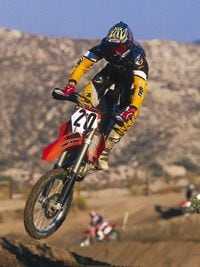
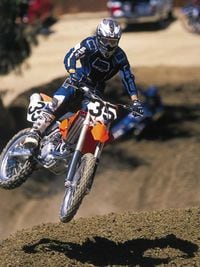
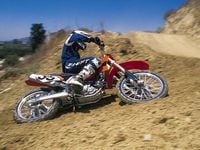
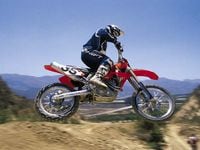
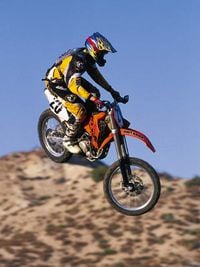
/cloudfront-us-east-1.images.arcpublishing.com/octane/5KYMT24REJEFPNO2J2M76MXERM.jpg)
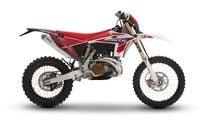
/cloudfront-us-east-1.images.arcpublishing.com/octane/3GXGR3EKSNH5NI3CWHV5SJ7TXE.jpg)
/cloudfront-us-east-1.images.arcpublishing.com/octane/JEU3ONDWEFCAZNAZJOU24OJ2PM.jpg)
/cloudfront-us-east-1.images.arcpublishing.com/octane/JQ6LMK6LLBAQJIL2AH56UIUKWU.jpg)
/cloudfront-us-east-1.images.arcpublishing.com/octane/QUSF4LLRM5DDPCJW25RINQRJPE.jpg)
/cloudfront-us-east-1.images.arcpublishing.com/octane/FYDGK7GF4JBPXERA5RAZPY3YJI.jpg)
/cloudfront-us-east-1.images.arcpublishing.com/octane/JE7KMNASNRGR7FLYAFRZAR7T7E.jpg)
/cloudfront-us-east-1.images.arcpublishing.com/octane/7RCNKJJNXBF4LBKZXE2INNWZUY.jpg)
/cloudfront-us-east-1.images.arcpublishing.com/octane/BAGM5E4EWBHFNLZOXMSLOLKQGU.jpg)
/cloudfront-us-east-1.images.arcpublishing.com/octane/RSX65VBXY5FRLIY4LN6WLOKAFM.jpg)
/cloudfront-us-east-1.images.arcpublishing.com/octane/3EO2CNKWUFBGNMGNJPETW5HCNY.jpg)
/cloudfront-us-east-1.images.arcpublishing.com/octane/IYHM55XRNVHF3DSS3467PZ7ONQ.jpg)
/cloudfront-us-east-1.images.arcpublishing.com/octane/L7K3FIINEBHMZI2TXTUE4FXH7I.jpg)
/cloudfront-us-east-1.images.arcpublishing.com/octane/XE7P5YXNZZDUTIGW4YNWQRDVY4.jpg)
/cloudfront-us-east-1.images.arcpublishing.com/octane/AV55DOHQ3BEXJLPWR6UWLYUSAQ.jpg)
/cloudfront-us-east-1.images.arcpublishing.com/octane/MMROGOYHXZAYDC4RKIDJ4VRSGA.jpg)
/cloudfront-us-east-1.images.arcpublishing.com/octane/FHRWLPEOTBFOHFTQLIHJNIXCFQ.jpg)
/cloudfront-us-east-1.images.arcpublishing.com/octane/J2RUDOXTOZHBXOFCUQKBAGBMAQ.jpg)
/cloudfront-us-east-1.images.arcpublishing.com/octane/UDQASRGJ3ZDG3BANXWU6P5NIQY.jpg)
/cloudfront-us-east-1.images.arcpublishing.com/octane/YIICVWCT7FDURLJQ2H4AIMXLOY.jpg)
/cloudfront-us-east-1.images.arcpublishing.com/octane/SKYGGQY3XJCPDAM4CUHUXBS444.jpg)
/cloudfront-us-east-1.images.arcpublishing.com/octane/AONOEIBHJBGMBOCD5HBWVB3UAI.jpg)
/cloudfront-us-east-1.images.arcpublishing.com/octane/76O4I66VBNBS5GXX4DNHXXKHR4.jpg)